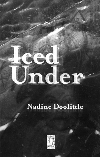
Iced Under
Nadine Doolittle
Bayeux Arts
$21.95
paper
237pp
978-1-897411-04-9
She comes to a ruined cottage by the shores of Hennessy Lake in West Quebec just after Christmas. Her poverty, isolation, the freezing pipes, and the chill of the cottage drive her to the point of desperation. She tries to chop a hole in the ice to get water, and sees a dead child amongst the frozen reeds.
Under the frozen water window, the grasses waved to her. She waved back. The lake groaned and the reeds parted:
A blink of something white.
Something down there. Moving in the icy tide.
A hand.
Doubting, Sara cupped her hands like a scuba mask and pressed her face to the ice. At the bottom of the lake, bobbing gently, a small white hand curled in among the reeds. Unmistakable. Hair-lifting, she heard herself whimper. Seconds passed, fully conscious now, her mouth drying –
The reeds flattened in an undertow and the face of a little girl stared up at her.
The reader can see the plot thickening long before Sara does. The tried-and-true elements of a romance novel – wounded hero, ruined house, unlikely villain – are used to great effect in Iced Under, adding to the Brontë-esque sense of brooding landscape and looming tragedy. Recurring motifs are ice and alcohol: both are essential elements in the remote Quebec village’s winter existence.
Doolitte’s language is gorgeous, her descriptions of the Gatineau countryside a dream:
Not so much as a streetlight shone on the lonely stretch of road that bisected a steep hill. On one side, mailboxes marked driveways that lunged up to homes screened by mini-forests, and on the other was a frozen marsh that disappeared in a tangle of grey scrub. The road crested and then flattened as the trees gave way to fields. A clutch of poplars and Manitoba maples competed for space in a stream that wound through the valley where dried yellow grasses stood waist deep above the snow.
But the glaring editorial mistakes do the author and the reader an injustice. To have so many oddly hyphenated adjectives, uncorrected verbs, and some odd facts (the mailman chasing Sara down to say she had to use her maiden name when in fact that only applies to women married in Quebec after a certain date) turned what should have been a smooth read into a bumpy one. mRb






0 Comments